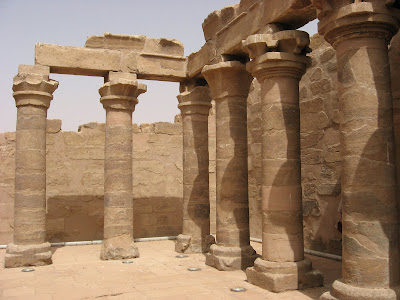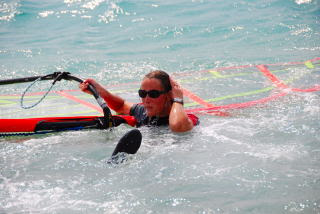 Google Earth image with the Temples of Wadi El Seboua, Dakka and Meharakka
Google Earth image with the Temples of Wadi El Seboua, Dakka and MeharakkaAll temples at this site were moved by UNESCO from their original, now submerged, location. Wadi El Seboua was the first temple we visited. It was a nice temple with an avenue of 10 sphinxes on the approach to its first pylon. The oldest part of the temple was build by Amenhoteb III (1390-1352 BC). During year 35-50 of the reign of Ramses II (1279-1213 BC) the temple was enlarged en restored and the typical Ramses II megalomaniac statues and sphinxes were added. The sanctuary showed nice engravings and a niche with the destroyed statues of Amon-Ra, Ra-Harakhty and Ramses II himself.
 Avenue of sphinxes
Avenue of sphinxes
 Colossal Ramses statues
Colossal Ramses statues Engravings in the sanctuary of the temple of Wadi el Seboua
Engravings in the sanctuary of the temple of Wadi el Seboua Temple of Dakka with its 12m-high pylon
Temple of Dakka with its 12m-high pylonThe temple of Dakka (ancient Egyptian Pselqet) is a smaller temple and was build over time by several ancient rulers like Ptolemy IV Philopator, Ptolemy VIII Euergentes II, the Nubian king Arqamani (218-200 BC), and roman emperors Augustus and Tiberius.
The temple is dedicated to Thoth, god of wisdom, usually depicted as a human with an ibis head.
 Engraving with Thoth, God of wisdom in the middle
Engraving with Thoth, God of wisdom in the middleHere the UNESCO moving operation let to the discovery of an earlier Horus temple built by Hatshepsut and Thutmosis III.
Temple of MeharakkaThe smallest temple we saw on this site was the temple of Meharakka, which was build under Roman rule. The temple was not finished, but is special because it has the only spiral staircase in any ancient Egyptian structure. It was dedicated to Serapis, the Alexandrian god. This god was introduced in Egypt in Ptolemaic times, and is a fusion of the Egyptian Gods Osiris and Apis and the Greek gods Zeus and Aesculape.
 The columns of the unfinished temple of Meharakka
The columns of the unfinished temple of MeharakkaOn the beach small motorboats were waiting for us to bring us back to the Kasr Ibrim. We sailed further south along Lake Nasser, to our last stop for the day, near the temples of Amada, Derr and the tomb of Penout. We enjoyed the weather (43C!) on the upper deck with a breeze and a swimming pool to cool off in.
 Google Earth image of the route of the Kasr Ibrim from Wadi el Seboua to Amada
Google Earth image of the route of the Kasr Ibrim from Wadi el Seboua to AmadaAt about three o’clock the Kasr Ibrim docked again, and we were ready for the next excursion. A small motorboat took us to the beach were there was the site of two temples and a tomb.
 Google Earth image of the site of the temples of Amada and Derr and the tomb of Penout
Google Earth image of the site of the temples of Amada and Derr and the tomb of PenoutThe temple of Amada was build by Thutmosis III and Amenhotep II (18th dynasty) in honour of the Gods Amon-Ra and Ra-Harakhty. Seti I and Ramses II have carried out minor restorations to this temple and added decorations. This is the oldest temple on Lake Nasser’s shores. In the inner part of the temple are beautiful murals. Unfortunately the generators at this site had ran out diesel, so the innermost parts of the temples were pith dark, apart from the small light bundle from the guide’s torch.
 The temple of Amada
The temple of AmadaInside the temple there is an interesting hieroglyphic text dating from the 3rd year of Amenhotep’s reign (1424BC). It describes the victorious military campaign into Asia: ”His Majesty returned in joy to his father Amon after he had slain with his own mace the seven chiefs in the district of Takhesy (in Syria), who were then hung upside down from the prow of the boat of His Majesty”.
 Hieroglyphic text of Amenhotep's victory, note the upside down chief in the middle.
Hieroglyphic text of Amenhotep's victory, note the upside down chief in the middle.This temple was for a long time partly buried in sand and Bedouins have left carvings of camels and horses high on the walls (then much lower because of the sand).
 Late Bedouin rock carvings in the temple of Amada
Late Bedouin rock carvings in the temple of AmadaThe murals posed a problem for the UNESCO temple movers in the 60s. The French were responsible for this temple, but they could not dismantle it without damaging the murals. So they did not dismantle it but they reinforced the temple and build a triple railroad track under the temple. On these tracks the temple was moved in one piece over 40km in six months. Because of the remoteness it was difficult to build a complete 40 km track. In stead they build short track and after track length they dismantled the track behind and rebuild it in front of the temple.
Temple of DerrUnlike the other temples on Lake Nasser, the Nubian rock-cut temple of Derr was located originally on the east bank of the river (now moved west), probably because the river makes an unnatural bend. The plan of the temple resembles that of the temple of Ramses II in Abu Simbel and shows scenes of Ramses II worshipped as a living god. Like in Abu Simbel, the inner sanctuary shows damaged statues of Ra-Harakhty, Amon-Ra, Ptah and Ramses himself. The statues were damaged when the Christians used the temple later as church.
 Inside the temple of Derr
Inside the temple of Derr
 Beautiful wall paintings in the temple of Derr
Beautiful wall paintings in the temple of DerrPenout was a governor of Lower Nubia during the reign of Ramses IV (12th century BC). He was probably Nubian as in the Egyptian tradition people were buried in the land where they were born. The rock cut tomb is decorated with wall paintings depicting scenes of Penout’s life. Unfortunately many were damaged when peoples tried to steal some of these decorations.
 Wall paintings in the tomb of Penout
Wall paintings in the tomb of PenoutAfter this last temple of the day we walked back to the Lake Nasser beach, where we saw hundreds of dragonflies. This time we did not only see the red and blue varieties, but also one with black wing tips.
 Dragonfly with black patches on its wings
Dragonfly with black patches on its wings
 The mountains around Mons Claudianus on Google Earth. The red line in the bottom right is the Safaga to Qena road. The line from the bottom right to the upper left is our off road track to Mons Claudianus.
The mountains around Mons Claudianus on Google Earth. The red line in the bottom right is the Safaga to Qena road. The line from the bottom right to the upper left is our off road track to Mons Claudianus.
























































